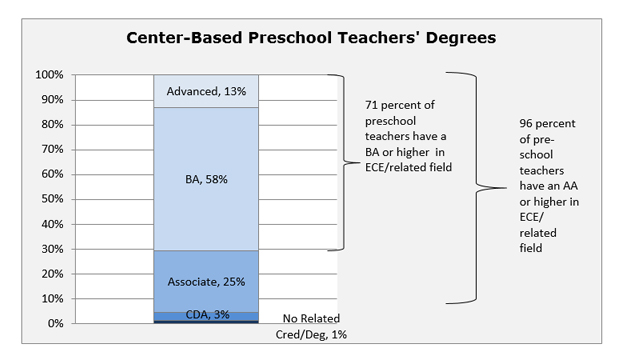Throughout this fact sheet, unless otherwise specified, the term "Head Start" refers to the Head Start program as a whole, including: Head Start services to preschool children; Early Head Start (EHS) services to infants, toddlers, and pregnant women; services to families by American Indian and Alaska Native (AIAN) programs; and services to families by Migrant and Seasonal Head Start (MSHS) programs.
The term "funded enrollment" refers to the number of children and pregnant women that are supported by federal Head Start funds in a program at any one time during the program year; these are sometimes referred to as enrollment slots. Funded enrollment numbers include enrollment slots funded by state or other funds when used by grantees as required nonfederal match. States may provide additional funding to local Head Start programs, which is not included in federal Head Start reporting.
The term "cumulative enrollment" refers to the actual number of children and pregnant women that Head Start programs serve throughout the entire program year, inclusive of enrollees who left during the program year and the enrollees who filled those empty places. Due to turnover, more children and families may receive Head Start services cumulatively throughout the program year, all of whom are reported in the Program Information Report (PIR), than indicated by the funded enrollment numbers.
The Congress of the United States authorizes the amount of federal spending for Head Start each year. The Head Start program is administered by the Administration for Children and Families (ACF) within the Department of Health and Human Services (HHS). Federal grants are awarded directly to public agencies, private nonprofit and for-profit organizations, tribal governments, and school systems for the purpose of operating Head Start programs in local communities.
Head Start Federal Funding
| Local Head Start Projects | Appropriation |
|---|---|
| States and Territories | $7,225,040,000 |
| American Indian and Alaska Native and Migrant and Seasonal Programs | $557,380,000 |
| Subtotal | $7,782,420,000 |
| Support Activities | |
| Training and Technical Assistance | $203,322,000 |
| Research, Demonstration, and Evaluation | $20,000,000 |
| Monitoring Support | $42,000,000 |
| Program Support | $25,353,000 |
| Transition Funding for Designation Renewal System (DRS)1 | $25,000,000 |
| Subtotal | $315,675,000 |
| Early Head Start - Child Care Partnerships2 | $500,000,000 |
| TOTAL3 | $8,598,095,000 |
1The Transition Funding for Designation Renewal System refers to funds available to minimize any disruption in services when there is a change in provider as a result of the DRS.
2The fiscal year (FY) 2014 appropriation included $500 million to expand access to high-quality early learning and development opportunities for infants and toddlers through Early Head Start-Child Care Partnerships. Funds must be obligated by March 31, 2015.
3The total above represents the funding available to the Head Start program after Congress restored funds in the amount of the previous fiscal year’s sequestration.
The Head Start program serves children, families, and pregnant women in all 50 states, the District of Columbia, and six territories. The table in this section presents the total allocations and funded enrollment of Head Start programs in each state and territory.
American Indian and Alaska Native (AIAN) funding is awarded to AIAN tribal governments. AIAN programs operate in 26 states, and in some cases their services cross state lines. Migrant and Seasonal Head Start funding and funded enrollment are shown as one total, as this program supports children and families who receive services in various states during the year. Thus, federal funding and funded enrollment for these services cannot simply be attributed to individual states.
Federal Funding and Funded Enrollment by State
| STATE/TERRITORY | FEDERAL FUNDING by State/Territory | FUNDED ENROLLMENT by State/Territory | FEDERAL FUNDING for AIAN1 | FUNDED ENROLLMENT for AIAN1 |
|---|---|---|---|---|
| Alabama | $124,377,203 | 16,606 | ||
| Alaska | $14,677,625 | 1,632 | $20,367,652 | 1,645 |
| Arizona | $121,586,377 | 14,065 | $40,216,130 | 3,936 |
| Arkansas | $73,063,664 | 10,034 | ||
| California | $979,754,551 | 101,189 | $8,214,838 | 632 |
| Colorado | $83,043,878 | 10,538 | $2,311,376 | 191 |
| Connecticut | $62,589,568 | 6,701 | ||
| Delaware | $15,172,449 | 2,209 | ||
| District of Columbia | $27,977,602 | 3,106 | ||
| Florida | $318,389,657 | 37,609 | ||
| Georgia | $203,399,319 | 24,191 | ||
| Hawaii | $26,060,039 | 3,152 | ||
| Idaho | $26,697,173 | 3,111 | $3,456,600 | 319 |
| Illinois | $321,387,029 | 40,898 | ||
| Indiana | $113,430,566 | 15,179 | ||
| Iowa | $60,129,449 | 7,680 | ||
| Kansas | $60,237,400 | 8,556 | $1,145,185 | 84 |
| Kentucky | $128,035,469 | 15,960 | ||
| Louisiana | $166,131,337 | 21,772 | ||
| Maine | $32,208,621 | 3,237 | $757,275 | 60 |
| Maryland | $91,807,269 | 10,273 | ||
| Massachusetts | $124,459,511 | 12,501 | ||
| Michigan | $271,485,932 | 32,708 | $6,928,707 | 596 |
| Minnesota | $85,086,710 | 11,288 | $10,737,229 | 932 |
| Mississippi | $182,885,459 | 26,782 | $2,218,116 | 268 |
| Missouri | $141,473,617 | 17,527 | ||
| Montana | $24,385,336 | 3,055 | $15,311,257 | 1,692 |
| Nebraska | $42,962,702 | 5,204 | $1,942,332 | 226 |
| Nevada | $28,416,227 | 2,852 | $3,513,542 | 362 |
| New Hampshire | $15,739,084 | 1,650 | ||
| New Jersey | $156,698,017 | 15,074 | ||
| New Mexico | $61,861,561 | 7,672 | $16,682,165 | 1,689 |
| New York | $505,464,030 | 50,216 | $1,331,753 | 143 |
| North Carolina | $171,279,580 | 20,278 | $2,853,094 | 230 |
| North Dakota | $20,359,378 | 2,378 | $10,094,047 | 1,000 |
| Ohio | $291,584,452 | 39,293 | ||
| Oklahoma | $99,351,062 | 13,986 | $24,030,953 | 2,822 |
| Oregon | $71,691,114 | 12,741 | $3,598,471 | 400 |
| Pennsylvania | $270,312,578 | 36,626 | ||
| Rhode Island | $25,484,182 | 2,811 | ||
| South Carolina | $101,263,106 | 12,860 | $953,479 | 80 |
| South Dakota | $21,988,051 | 2,890 | $16,293,892 | 1,690 |
| Tennessee | $136,892,761 | 16,841 | ||
| Texas | $570,538,533 | 71,465 | $434,688 | 34 |
| Utah | $48,418,043 | 6,080 | $1,789,758 | 215 |
| Vermont | $15,535,073 | 1,448 | ||
| Virginia | $117,220,586 | 14,590 | ||
| Washington | $123,638,128 | 12,423 | $14,125,023 | 1,415 |
| West Virginia | $59,476,634 | 7,978 | ||
| Wisconsin | $105,704,455 | 14,218 | $10,471,303 | 1,032 |
| Wyoming | $13,750,805 | 1,658 | $2,943,488 | 295 |
| Subtotal States: | $6,955,562,952 | 834,791 | ||
| Subtotal Indian Tribes: |
$222,722,353 | 21,988 | ||
| Migrant Programs | $332,402,268 | 30,276 | ||
| American Samoa | $2,339,933 | 1,332 | ||
| Guam | $2,558,825 | 534 | ||
| No. Marianas | $1,859,836 | 462 | ||
| Palau | $1,460,671 | 400 | ||
| Puerto Rico | $278,608,717 | 36,478 | ||
| Virgin Islands | $9,628,366 | 1,014 | ||
| TOTAL | $7,807,143,921 | 927,275 |
1AIAN funding is awarded to American Indian and Alaska Native tribes. For reference, the funding and enrollment has been split out by the state in which the tribe is headquartered. Some tribes serve children across state lines.
Each year, Head Start programs are required to submit Program Information Reports (PIRs) on the services they have provided to children and families throughout the program year, including child, family, and staff demographics and program characteristics.
For a copy of the PIR form, detailed reports, and data sets for the 2014 PIR and prior years, and for further information, please visit: https://eclkc.ohs.acf.hhs.gov/data-ongoing-monitoring/article/program-information-report-pir.
Program Characteristics:
- Forty-two percent of grantees operated Head Start preschool services only.
- Thirteen percent of grantees operated Early Head Start (EHS) services only.
- Forty-five percent of grantees operated both Head Start and Early Head Start services.
Most Head Start preschool services were provided in center-based settings that, based on local design, vary in the number of days per week and hours per day classes are in session. About half of EHS services were provided in center-based settings, and half were offered in home-based program settings.
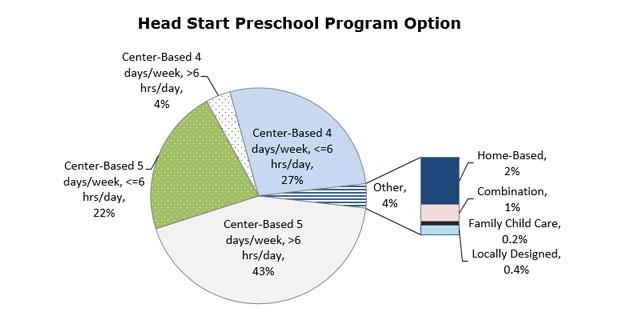
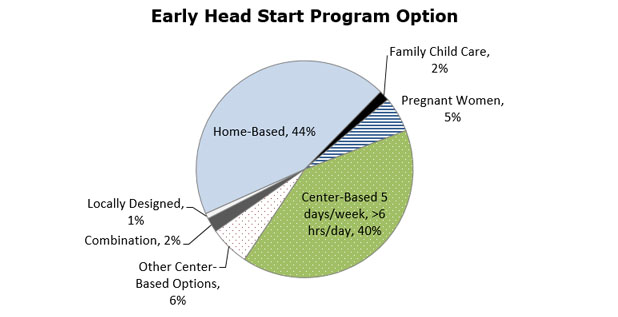
Child and Family Demographics:
Head Start programs cumulatively served 1,076,000 children ages birth to 5 and pregnant women throughout the 2013-14 program year.
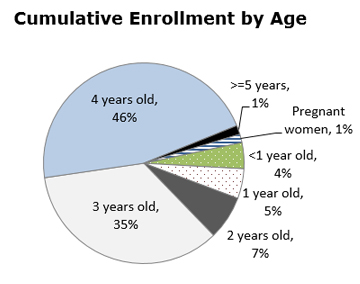
Head Start served a diverse group of children, families, and pregnant women. Thirty-eight percent identified themselves as Hispanic/Latino, and almost 29 percent were Black/African American.
Families were asked to self-identify both an ethnicity and a race category based on U.S. Census Bureau measures. For example, a family that identifies their child as Black and Cuban was counted in the "Black or African American" race category for the race question and counted in the "Hispanic or Latino" category for the separate question on ethnicity.
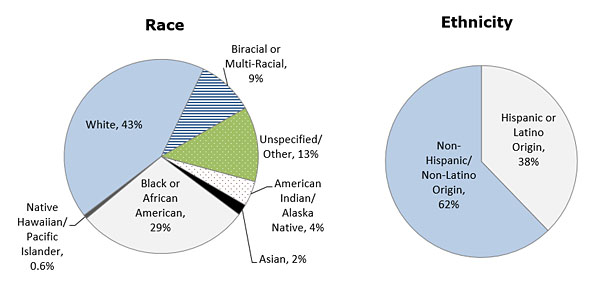
Thirty percent of participants were from families that primarily spoke a language other than English at home. Twenty-five percent of participants were from families that primarily spoke Spanish at home.
Services to Children and Families:
Head Start programs work with families to help ensure children have access to needed services and resources. The number of children who received immunizations increased from the beginning of the program year to the end of the program year. Also, more families had health insurance and medical and dental homes for their children at the end of the 2013-14 program year than at the beginning.
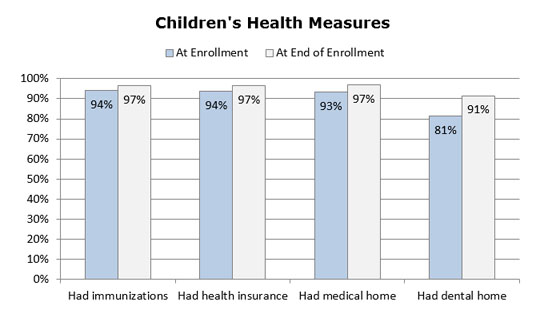
Head Start programs work with families to ensure they have the means to obtain health insurance, services for children with disabilities, adequate housing, job training, and more. In FY 2014:
- Most children had public health insurance. At the end of the program year, 89 percent of children were enrolled in Medicaid, the Children's Health Insurance Program (CHIP), or a state-funded child health insurance program.
- Twelve percent of Head Start cumulative enrollment was made up of children with disabilities, defined as children having special plans under the Individuals with Disabilities Education Act (IDEA). In comparison, nationally, about three percent of infants and toddlers and six percent of preschool-age children have identified disabilities. Head Start serves a greater percentage of children with disabilities than found in the overall population.
- Among pregnant women enrolled in EHS, approximately 91 percent received prenatal education on fetal development and 21 percent had medically high risk pregnancies.
- Head Start served about 989,000 families cumulatively throughout the program year. The number of families served is a little less than the number of participants served, since some families have more than one child enrolled.
- Approximately 45,000 families served during the enrollment year experienced homelessness. Of those families, 33 percent found housing during the program year. Nearly 90,000 Head Start families received housing assistance such as subsidies, utilities, and repairs.
- Approximately 217,000 families, or 22 percent, received services related to job training and adult education such as general education development (GED) programs and college selection.
Program Staff:
Head Start programs employed and contracted with 239,000 staff. Parents of current or former Head Start children made up 24 percent of Head Start staff.
- More than 1.1 million adults volunteered in their local Head Start program. Of these, 800,000 were parents of Head Start children.
- About 116,000 staff members provided child development services to children, including teachers, assistant teachers, home visitors, and family child care providers.
- Among child development staff, 30 percent were proficient in a language other than English.
- Seventy-one percent of all Head Start center-based preschool teachers had a baccalaureate degree or higher in early childhood education, or in a related field with experience. The Head Start Act specifies that 50 percent of center-based preschool teachers nationwide should have had these credentials by 2013.
